|

 Up
Up 
 Dayton OH
Dayton OH

(You are here.)
Outerbanks NC 
Washington DC 
Indiana

Elsewhere

 Down
Down




  Need
to Need
to
find your
bearings?
Try
these
navigation aids:
If this
is your first
visit, please stop by:
Something
to share?
Please:



|
|
Available in Française, Español, Português, Deutsch, Россию,
中文,
日本, and others.
 he
Wright family were among the pioneers who settled the Northwest
Territory
in the early nineteenth century. Their great-grandfather, Dan
Wright, brought his family to Ohio in 1814 and bought a piece of
land adjacent to the new National Road in what is now Miami County,
just north of Dayton, OH. Dan's son, Dan Jr. moved to Rush County,
Indiana where his son Milton – the father of the Wright brothers –
was born. Milton became a preacher in the United Brethren Church,
then was promoted to edit the Religious Telescope, published
by the United Brethren in Dayton. Milton would have other church
assignments that took him and his family elsewhere, but they always
came back to Dayton. In 1884, the Wright family – including Orville
and Wilbur Wright – moved to Dayton permanently. Both Orville and
Wilbur were life-long residents from that moment. he
Wright family were among the pioneers who settled the Northwest
Territory
in the early nineteenth century. Their great-grandfather, Dan
Wright, brought his family to Ohio in 1814 and bought a piece of
land adjacent to the new National Road in what is now Miami County,
just north of Dayton, OH. Dan's son, Dan Jr. moved to Rush County,
Indiana where his son Milton – the father of the Wright brothers –
was born. Milton became a preacher in the United Brethren Church,
then was promoted to edit the Religious Telescope, published
by the United Brethren in Dayton. Milton would have other church
assignments that took him and his family elsewhere, but they always
came back to Dayton. In 1884, the Wright family – including Orville
and Wilbur Wright – moved to Dayton permanently. Both Orville and
Wilbur were life-long residents from that moment.
Because of their long history with Dayton, there are many places in
Dayton that can claim some involvement with the Wright
brothers. We've listed a few here that will be of most interest to
aviators, historians, and scholars.
Up for a virtual expedition? With each of these locations we offer
the option "Click HERE to visit..." This is a link to a KMZ
file or placemark in Google Earth. When you click on the
link, a box will appear asking if you want open, save, or cancel the
file. Choose "Open" to run Google Earth and view the file
immediately. Choose "Save" if to save the placemark and view it
later. Note: You must have Google Earth installed to follow the
placemark. If you do not already have Google Earth,
go HERE.
|
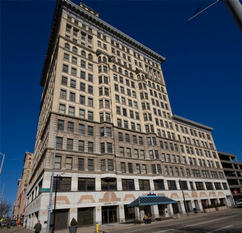
Dayton fairly oozes with pioneer aviation history. This, for
example, is the Centre City Building at 40 South Main Street. It was
built on the site of the United Brethren publishing business where
Bishop Milton Wright once worked. In 1910, the Wright Exhibition
Team – the "Wright Fliers" who demonstrated Wright aircraft – rented
an office on the thirteenth floor.
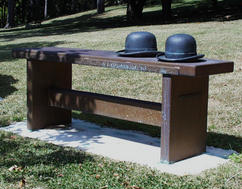
One of the most poignant and creative memorials to the Wright
brothers in Dayton are these "bowler benches" created by sculptor
David Black. Nine were cast and placed at various locations around
the city such as Woodlawn Cemetery and the Dayton Engineers Club.
The inscription reads "Dedicated to the immortal spirit of Wilbur
and Orville Wright."
|
Carillon Park
1000 Carillon Boulevard, Dayton, OH 45409
After World War II, Industrialist Edward R. Deeds, the
founder of Delco and the Dayton Wright Airplane Company,
began to collect historic buildings and artifacts from
Dayton's industrial past. His goal was to create a "walking
village," much like Ford's Greenfield Village, that would
showcase Dayton's contributions to science and technology,
in particular, transportation. In 1946, he asked Orville
Wright if he could contribute a Wright aircraft or build a
replica. Orville retrieved the remains of the 1905 Wright
Flyer III from Zenas Crane of Pittsfield, MS who had
salvaged the airplane in 1914 and former Wright Company
employee, Harvey P. Geyer, was hired
to head the restoration. The restored aircraft was unveiled
in 1950 and is now a National Historic Landmark. It rests in
the Wright Brothers Aviation Center on the Carillon Park
campus. Visitors enter the Center through a replica of the
old Wright bicycle shop at 1127 West Third St. and walk
through a history of the Wright brothers from their
days as bicycle manufacturers to Wilbur's triumphant flight
around the Statue of Liberty in 1909. The Flyer is nicely
displayed in what the docents call the "Pit," which allows
you walk all around the Flyer and inspect it from slightly
above.
- CLICK
HERE to visit Carillon Park in Google Earth.
-
CLICK HERE to visit the Carillon Park web site.
- CLICK HERE to take a virtual tour around the Pit and
see the 1905 Wright Flyer III from every angle.
|
|
|
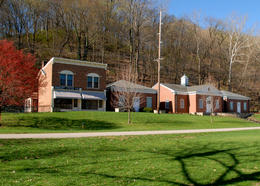
This is the Wright Brothers complex in Carillon park,
providing a walk-through history of the Wrights from 1897 to
1909.
|
|
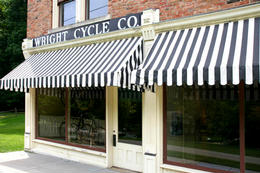
The shop windows of the replicated Wright Cycle Company. You
enter the complex through the door of the bicycle shop.
|
|
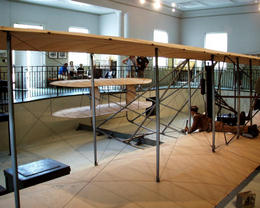
The 1905 Wright Flyer III in the "pit" in Wright Hall. The
box in front of the left wing is the Wrights' tool chest.
|
|
Dayton Engineers Club
110
East Monument Avenue, Dayton, OH 45402
In 1914, Dayton was a leading industrial city, the "city of
a thousand factories." It actually led in one important
category -- innovation. More patents per capita were filed
in Dayton than anywhere else in the world. Edward Deeds, one
of the founders on Delco (later part of General Motors),
and Charles Kettering, inventor of the electric starter for
automobiles, led a small group of engineers who called
themselves the "Barn Gang" and met on Deeds' property to
share ideas. Realizing the need for a more formal structure,
Deeds suggested forming an "engineers club." The Barn Gang
adopted the idea and by 1918 had a handsome clubhouse
overlooking the Great Miami River. Orville Wright, who was
the president of the club at the time, gave a rare public
speech when the doors were opened. Orville also contributed
some important Wright artifacts, among them Wright Engine
No. 3 (built in 1904) and Orville's Pilot's License No. 1.
Both are on display in the Club. The Club also owns the only
know recording of Orville Wright's voice. It's a video about
the founding of the Engineers Club and he says just a few
words to Deeds and Kettering. And right next door to the
Club is an awesome monument showing Orville and Wilbur
flying the 1905 Wright Flyer III.
-
CLICK
HERE to visit the Dayton Engineers Club in Google Earth.
-
CLICK HERE for the Engineers Club of Dayton web
site.
|
|
|
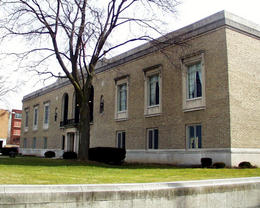
The front of the Dayton Engineers Club. The building is
located just a few feet away from where the first settlers
– among them the Wright brothers' great-great-grandmother – first
stepped ashore from the boat that brought them upriver to
Dayton.
|
|
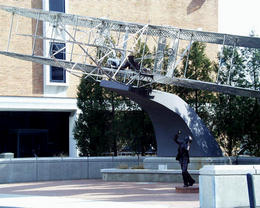
Just next door to the Engineers Club is a life-size statue
of the 1905 Wright Flyer in flight. Wilbur is the pilot while
Orville runs along beneath the aircraft,
|
|
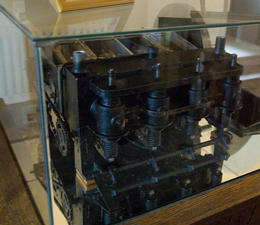
Wright Engine No. 3, on display upstairs in the Dayton
Engineers Club, along with other artifacts from famous
inventors, scientists, and businessmen who were members of
the club.
|
Dayton Metro Library
215 E. Third Street, Dayton, OH 45402
In 1948, When Orville Wright died, the executors of his
estate had many of his papers moved to the main branch of
the Dayton library in downtown Dayton. Currently the library
houses over 9800 items related to the Wright brothers which,
according to their own web site, "illuminate the Wrights'
place in aviation history and in the hearts and minds of
their fellow Daytonians." Some of the most interesting
pieces in this collection are the annual minutes of the "Ten
Boys Club," an informal best-friends-forever tontine that
included the three older Wright brothers, Reuchlin, Lorin,
and Wilbur, (Orville was too young to join.)
Because the minutes include personal news about each of the
members, you can see how each young man made his way through
life. The collection also includes an in-depth account of
the Dayton homecoming celebration which welcomed the Wright
brothers and their sister Katharine back from their
triumphant tour of Europe in 1909. Scrapbooks and postcards
describe the most minute details, including schedules of
parades, receptions, award ceremonies, fairground
exhibitions, speeches, and fireworks. There is even a
biography of the man who orchestrated the event, Henry Kabierske, a professional event designer who had once worked
for the King of Prussia. In addition to this rich
collection, the library also has most of the Dayton and
Dayton area newspapers, either on microfilm or digitally
scanned. You can read for yourself the reaction of the
Wright brothers' neighbors to their accomplishments as events
unfolded.
-
CLICK
HERE to visit the Dayton Metro Library in Google Earth.
-
CLICK HERE for the Dayton Metro Library web site,
History and Genealogy section.
|
|
|
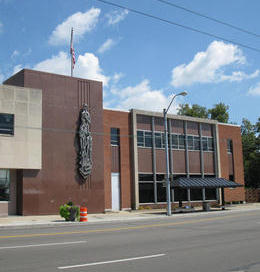
The Third Street Entrance to the Dayton Metro Library.
|
|
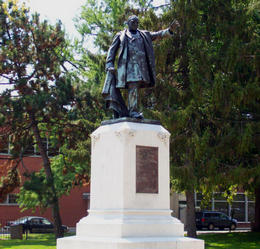
A statue of President William McKinley in Cooper Park behind
the library. McKinley is one of seven Ohioans to make it to
the White House.
|
|
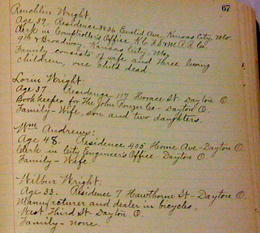
The minutes of the annual meeting of the Ten Dayton Boys
Club from 1900, showing the status of Reuchlin, Lorin, and
Wilbur Wright. Wilbur was in fact absent from the meeting;
he was on his first trip to Kitty Hawk, NC.
|
Deeds Point
510 Webster Street, Dayton, OH 45404
|
Deeds Point is a small park at the confluence of the Great
Miami and Mad Rivers, overlooking downtown Dayton, Ohio. It
is the southernmost tip of what used to be McCook Field,
the very first experimental airfield and laboratory where
the Army Air Corps began to push the edge of the flight
envelope. Opened in 1917, this small airfield was the site
of many important aviation advances, including instrument
landings, emergency parachutes, night flight, even crop
dusting. Orville Wright did some innovative work here,
consulting on aircraft engineering and helped to create the
military's first comparative survey of air foils. Curiously,
the monument at Deeds Point commemorates none of these
things and barely mentions McCook Field. Instead, the focus
is on an event that happened several miles away in 1899.
Life-size bronze figures of Wilbur and Orville Wright
re-enact the moment at which Wilbur shows Orville how to
twist the wings of a biplane, causing it to roll. Orville twists a small cardboard
box while Wilbur walks him through the concept. This was the
"inner tube box experiment," the very beginnings of the aerodynamic
control system now used by most aircraft. Wilbur discovered
this phenomenon, then showed it to his brother in their
bicycle shop at 1127 West Third Street. Said bicycle shop
was carted off to Greenfield Village in Dearborn, Michigan
in the 1930s. Ever since, the spot at 1127 West Third Street has been a vacant lot in
sad need of a monument – just like this.
|
|
|
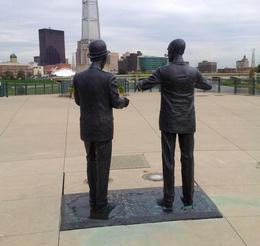
Orville and Wilbur at Deeds Point, facing the Dayton skyline
across the Great Miami River.
|
|
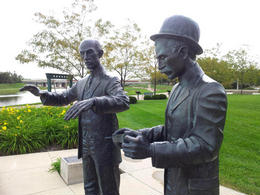
A close-up of the two statues. Orville tries to twist the
box while Wilbur explains the process of wing warping.
Orville is not holding the box correctly; see the
Inner Tube Box Experiment.
|
|
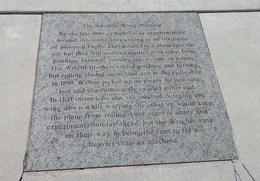
The interpretive material at Deeds Point
also has inaccuracies. In 1899 the Wrights had
not
"solved...turning." They thought that rolling an
airplane by twisting its wings would result in a turn. Later
experiments would show this was only half the solution. They would not discover
how to turn an airplane until 1902. See
The Last Piece of the Puzzle.
|
Hawthorn Hill
901 Harmon Avenue, Oakwood, OH 45419
Named for the many Hawthorn trees growing on the property,
Hawthorn Hill was home to Milton Wright until his death in
1917, Katharine Wright until her marriage in 1926, and
Orville Wright until his death in 1948. Although he never
lived there, Wilbur helped to design the house but died of
typhoid fever two years before the mansion was completed in
1914. The house was designed by
the architectural firm of Schenck and Williams, patterned
after a "Greek Revival" southern mansion – it was a
style that the Wrights had admired when they visited Fort
Myer, Virginia to demonstrate their
airplane. Originally the building set on 17
acres but only a little over 1 acre remains. Over the
years, Orville filled the home with many of his own devices,
including a circular shower, a metal cistern to collect
rainwater, a system to purify and soften the water, a system
of chain and rods that allowed Orville to adjust the furnace
from the upstairs rooms, a toaster that sliced and browned
bread, and a special easy chair with a reading stand.
Hawthorne Hill was called Orville Wright's "machine for
living." Notables that visited the mansion include
Thomas Edison, Alexander Graham Bell, Carl Sandburg, Admiral
Richard Byrd, King Constantine of Greece and President
Franklin D. Roosevelt. Just weeks after he made his
pioneering flight from New York to Paris, Charles Lindbergh
was a guest at Hawthorn Hill. He had arrived too late to
make a personal appearance in a public place, so a crowd gathered on the lawn
and clamored for their hero. Orville prevailed on Lindbergh
to do something to mollify the crowd, so Lindbergh and
Orville made a brief appearance on the balcony. The crowd
dispersed, satisfied.
- CLICK
HERE to visit Hawthorne Hill in Google Earth.
-
CLICK HERE for information about visiting Hawthorn
Hill.
|
|
|

The entrance to Hawthorn Hill. The balcony above the door
is where Charles Lindbergh appeared with Orville in 1927.
|
|

The back door of Hawthorn Hill. The mansion is precisely
symmetrical. It displays the same colonnade front and back
and same porches on either side.
|
|
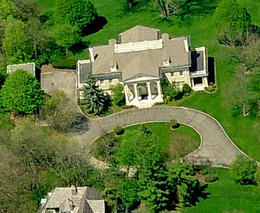
A bird's-eye view of Hawthorn Hill.
|
Huffman Prairie
Wright-Patterson AFB, OH 45433
Orville Wright first visited Huffman prairie when he was
still in high school. His teacher William Werthner took
Orville's class on field trips to the spot where, in the
1830s, botanist John Leonard Riddell had discovered three
new species of plants. (Riddell was also one of the earliest
science fiction writers and wrote about "aerial navigation."
) The prairie was a boggy piece of real estate with poor
drainage. It was unproductive as farmland, so the owner Torrence
Huffman needed little convincing to allow Orville and Wilbur
to use it. They built a small hangar in one corner of the 84
acres and conducted flight experiments there in 1904 and
1905, working to develop their invention into a
commercial product. The Wrights built a larger hangar in
1910 and used it for test flights and as a flight school
until 1915. Over 100 of America's first pilots learned to
fly here, including Hap Arnold, the first commander of the
US Air Force. In 1917, the US Army purchased the field
along with 2,000 adjacent acres, and renamed it Wilbur
Wright Field. It became a training grounds for Army pilots.
The facility expanded to 4,500 acres in 1927 to become Wright Field.
In 1948, six months after creation of the US Air Force from
the US Army Air Corps, the field merged with nearby
Patterson Field to become Wright-Patterson Air Force Base.
Buried deep within the base, the original Huffman Prairie
was off limits to civilian visitors, especially during the
Cold War. But in 1990, the prairie was designated a National
Historic Landmark and opened to the public. In 2002, it
became park of the Dayton Aviation Heritage National
Historic Park and today the prairie
is cared for by the National Park Service. Except in times
of high military alerts and inclement weather, visitors can drive directly onto
the field through Gate 16A off of Route 444.
- CLICK
HERE to visit Huffman Prairie in Google Earth.
-
CLICK HERE to visit the National Park Service's web
site for the Huffman Prairie Flying Field Interpretive
Center.
|
|
|
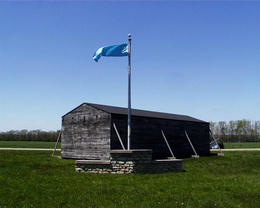
The boundaries of Huffman Prairie are marked with blue flags
at each corner. In one corner, there is a replica of the
1905 hangar.
|
|
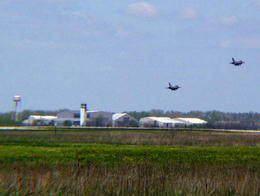
Off in the distance, you can see the hangars and other
buildings of Wright-Patterson Air Force Base. Occasionally, military aircraft practice
landings and take-offs on the nearby runway.
|
|
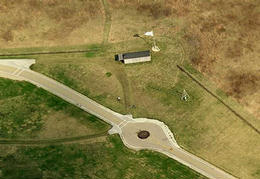
A view of Huffman Prairie from the air. A road running
through the field lets you drive around the area. A section
of the Prairie just to the east of the hangar has been
declared a State Natural Landmark where conservationists are
restoring the original prairie environment.
|
National Museum of the United States Air force
1100
Spaatz Street, Wright-Patterson AFB OH 45433
This is the official museum of the United States Air Force,
the oldest and largest military aviation museum in the
world, and the second most-visited museum in the United
States next to the Smithsonian. In began in 1923 when the
Engineering Division at Dayton's McCook Field first
collected engines and other technical artifacts for
preservation. In 1927, this "engineering museum" moved moved
to Wright Field and was housed in a succession of buildings.
In 1954 it became the Air Force Museum and occupied Building
89 of Wright-Patterson Air Force Base, Area C, which had been
an engine overhaul hangar. It moved to its present location
in 1971. Since then it has more than tripled in size. The
museum displays military planes of all aviation eras, from
the very beginnings of the US Army Air Corps to the present.
Because of this, there are no early experimental Wright
gliders or Flyers although, inexplicably, the museum does
exhibit a Chanute and a Lilienthal glider. But its Wright
collection starts with a reproduction of the 1909 Wright
Military Flyer, the first airplane purchased by the US Army.
(The original Wright Military Flyer is in the Smithsonian.)
There is also an original Wright Model B, although it has
been much modified with ailerons instead of wing warping and
a powerful 75 hp Rausenberger engine
in place of the original 35 hp Wright engine. Other pioneer
aircraft in the museum include 1911 American-built Bleriot
XI and a 1911 Curtiss Model D. The museum also exhibits the
160 mph wind tunnel from Orville Wright's 1916 laboratory,
as well as a replica of the Wrights 20 mph wind tunnel from
1901.
-
CLICK
HERE to visit the National Museum of the United
States Air Force in Google Earth.
-
CLICK HERE to visit the National Museum of the Air
Force web site.
|
|
|
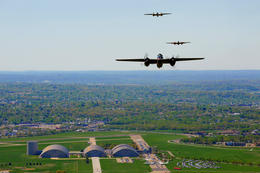
Vintage B-25 bombers fly over the National Museum of the
United States Air Force. The museum's collection is housed
in three huge hangars.
|
|
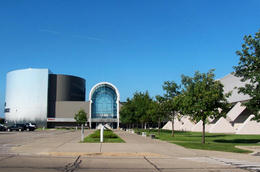
The entrance to the museum. To the left of the atrium is an
IMAX theater which features movies on flight.
|
|
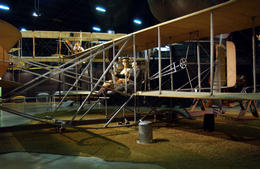
The replica of the 1909 Wright Military Flyer in the Early
Flight Gallery. The Curtiss Model D is visible behind the
Flyer.
|
Paul Laurence Dunbar Library Archives
Wright State University, 3640 Colonel Glenn Highway, Dayton, Ohio
45435
The Wright Brothers Collection on the fourth
floor of the Paul Laurence Dunbar Library
in Wright State University includes the Wrights’
own technical and personal library, family
papers including letters, diaries, financial
records, genealogical files, and other documents
detailing the lives and work of Wilbur and
Orville Wright and the Wright Family. For
example, you'll find here the account book of
the Wright Cycle Company and the hand-written
diaries of Bishop Milton Wright. The collection
also features awards, certificates, medals,
albums, recordings, and technical drawings.
Perhaps the most valuable part of it are the
thousands of photographs documenting the
invention of the airplane and the lives of the
Wright Family. Indeed, the library is the go-to
place for all Wright photography outside the
300+ photos that are in the Library of Congress
Collection. The collection was deeded to Wright
State University in 1975 by the Wright Family.
Since that time, there have been numerous
additions to the collection and donations of
related collections that have made this one of
the most astounding treasure troves of
pioneer aviation information in the world.
-
CLICK
HERE to visit the Paul Laurence Dunbar Library in Google Earth.
-
CLICK HERE to visit the Paul Laurence Dunbar
Library, Archives and Special Collections web site.
|
|
|
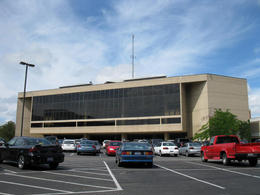
The Paul Laurence Dunbar Library at Wright State University
as seen from the parking lot.
|
|
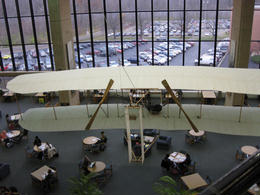
A replica of the 1903 Wright Flyer I hangs in the library's
atrium.
|
|
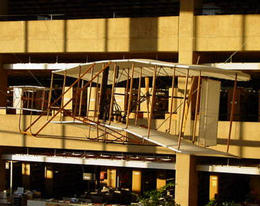
All four floors of the library are open to the atrium. The
archives are on the top (fourth) floor.
|
woodlawn cemetery and
Arboretum
118 Woodland Avenue, Dayton, OH 45409
Woodlawn Cemetery became Dayton's main cemetery in 1841 and
it remains an active burying ground and one of the oldest
rural garden cemeteries in America. It is also a spectacular
arboretum, with over 3,000 mature trees and 160 species of
woody plants on the premises. Its graves hold the bodies of
many prominent scientists and engineers, as well as some of
the industrial greats that helped make Dayton history. For
example, here you can find the resting place of John H.
Patterson, the founder of National Cash Register and the
father of the business machine industry. Or Charles F.
Kettering, the inventor of the automobile self-starter,
octane gasoline, coil ignition, and hundreds of other
automotive advancements. But the occupants aren't all
moguls and gear-nuts. There are some surprises, like Matilda
and Levi Stanley, the Queen and King of the Gypsies. Or
humorist Erma Bombeck and poet Paul Laurence Dunbar. Not far
from Dunbar's grave is the Wright family plot. Originally
the graves included Bishop Milton Wright and his wife Susan,
plus Wilbur, Orville, and Katharine. Recently, Otis and Ida
Wright were moved from another Dayton-area cemetery to
Woodlawn. These were the twin brother and sister of the
Wilbur and Orville who died in infancy. Caretakers of the
cemetery report that visitors often leave tokens on the
Wright brothers graves, including pilot's insignias, coins,
and occasionally a rubber band-powered airplane. Visitors
also take away acorns from the oak tree that shades the
Wrights' graves. There are more than a few "Wright Oaks"
growing at small airports across America. (Note: The best
time to gather these nuts is late August or early
September.)
- CLICK
HERE to visit the Woodlawn Cemetery and Arboretum in Google Earth.
-
CLICK HERE for a printable map of Woodlawn Cemetery,
showing the location of the Wright graves ("O" in
Section 101).
-
CLICK HERE to visit Woodlawn Cemetery's web site.
|
|
|
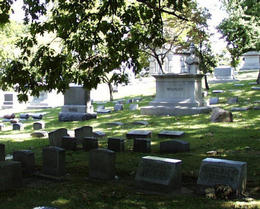
The oak-shaded Wright family plot in Woodlawn Cemetery.
|
|
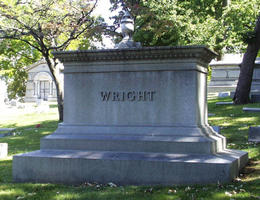
As was the custom in the late nineteenth century, the
individual headstones are small. There is a single large
monument for the entire family.
|
|
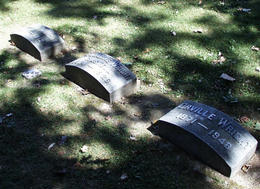
From left to right, the headstones of Wilbur, Katharine, and
Orville. These are downslope from the larger monument.
|
Wright Cycle Shop No. 4
22 South Williams Street, Dayton, OH 45402
The Wright brothers moved around a lot. Not only did the
family move a dozen times before it landed in Dayton
permanently, Wilbur and Orville moved their bicycle shop to
several locations before they landed and stuck. There were
six, all total -- 1005 West Third, 1015 West Third, 1034
West Third, 22 South Williams, 20 West Second, and finally
1127 West Third. It was this last location where they built
all of their experimental airplanes from the 1899 kite to
the 1905 Wright Flyer III, and this is the building that was
moved to Greenfield Village in Dearborn, MI. The fifth, on
Second Street across the Great Miami River, was just a
showcase. The fourth on Williams Street is where the Wright
brothers were working when they first began to manufacture
their own bicycles and when they began to study aviation in
earnest -- they were here from 1895 to 1897. They also
built their first internal combustion engine while they were
here, a one cylinder behemoth powered by natural gas that
ran their machine tools. This bicycle shop was "rediscovered"
by Fred Fisk and Marlin Todd in 1980 when they published an
article on Wright bicycles and a photo of Shop No. 4 in
The Wheelmen magazine. The building was restored by
Aviation Trail, Inc., a non-profit organization of Dayton
historians and aviation enthusiasts. Today it's managed by
the National Park Service.
-
CLICK
HERE to visit the Wright Cycle Shop No. 4 in Google Earth.
-
CLICK HERE to visit the National Park Service's web
site of the Dayton Aviation Heritage National Historic
Park.
|
|
|
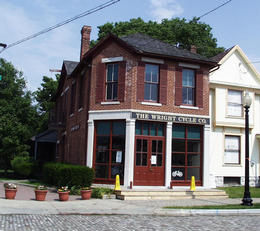
The Wright Cycle Company's shop No. 4 at 22 South Williams
Street, immediately after its restoration. The Wrights also moved
their printing business to the second floor.
|
|
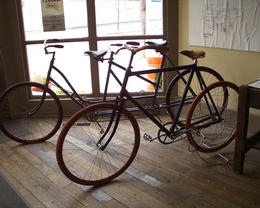
Several display bicycles at the Wright bicycle shop. The
Wrights sold many other brands besides their own.
|
|
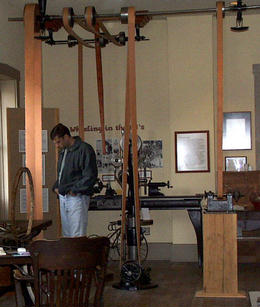
The shop area of the Wright bicycle shop.
|
Wright Hill Memorial
2380 Memorial Road, Wright-Patterson AFB, OH 45433
On a hill that overlooks Huffman Prairie, the citizens of
Dayton erected a shaft of North Carolina marble "in
commemoration of the courage, perseverance, and achievements
of Wilbur and Orville Wright." The memorial was dedicated
with Orville Wright in attendance in 1940; he was 69 years
old. As you walk around the terrace that encircles the
shaft, there are several bronze plaques inlaid in a low
stone wall. One contains the names of all 119 pioneer pilots
who were taught to fly at Huffman Prairie. Another talks
about the 160 flights the Wrights made over the prairie in
1904 and 1905, including the first complete circle. An arrow
on top of the wall points to Huffman Prairie and
Wright-Patterson Air Force Base, just over a mile away to
the northeast. To the west are several small Indian mounds,
discovered when the memorial was built. Just across the
parking lot from the memorial is the Huffman Prairie
Interpretive Center, a small museum operated by the National
Park Service. Huffman Prairie is maintained as a pristine
botanical prairie with a minimum of exhibits, much the same
way the Wright brothers found it in 1904. Consequently, all
the interpretive exhibits for the Wrights 1904-1905
experiments and their 1910-1915 flight school are up here on
the hill.
- CLICK
HERE to visit Wright Hill in Google Earth.
-
CLICK HERE to visit the National Park Service's web
site for the Huffman Prairie Flying Field Interpretive
Center.
|
|
|
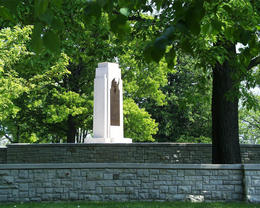
The Wright Brothers Memorial on Wright Hill. The shaft is
about 20 feet (6 meters) tall and surround by a wide
flagstone terrace.
|
|
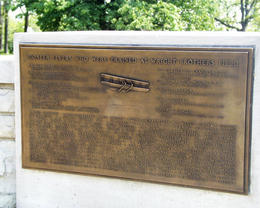
The list of 119 pioneer aviators who learned to fly at
Huffman Prairie.
|
|

The view of Huffman Prairie and Wright-Patterson Air Force
Base from Wright Hill.
|
wright factory
2815 West Third Street, Dayton, OH 45417
When the Wright Company incorporated in 1909, they began
work on two new factory buildings just off West Third
Street, 1.4 miles (2.3 kilometers) west of the Wright Cycle Shop. The
first of these was completed in November 1910 and the
Wright Company moved in. For a short time, this was the
busiest airplane factory on earth, turning out as many as
four airplanes every month. It didn't last, however. The
death of Wilbur Wright and the patent fights sapped the
company's creative talents and Wright airplanes became
increasingly outmoded as better designs were
produced by competitors. Orville sold the Wright Company to
New York investors in 1915 and the factory shut its doors.
It had produced just 120 airplanes. But they were opened again in1917 when Charles Kettering and
Edward Deeds organized the Dayton Wright Airplane Company to
manufacture DeHavilland 4 aircraft for the war in Europe. In
1923, the buildings were purchased by the Inland
Manufacturing Company, a division of General Motors, to make
automotive components such as chassis, brakes, springs,
steering wheels, and hundreds more. The facility grew
exponentially, erecting building after building over several
decades as new products were added. During World War II, the
complex even produced M-1 carbines. After corporate
restructuring in the 1990s, General Motors sold Inland to
its employees and the name was changed to Delphi. Delphi
struggled for several years, then closed most of its US
operations in 2005 and 2006, including the Inland's main
plant off West Third Street. The original Wright Company
buildings were put under the protection of the National Park
Service in 2009 and the entire plant is now under the
management of a group that is working to rid the site of
environmental contaminants. Most of the manufacturing
complex has been demolished, but several historic buildings
– including the original Wright Factory – have been
preserved. As of this writing (August 2017), it is not clear
when the building will be turned over to the National Park
Service.
- CLICK
HERE to visit the Wright Factory in Google Earth.
|
|
|
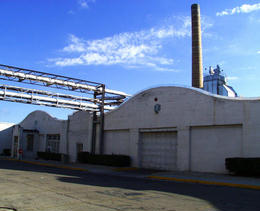
The Wright factory buildings as they appeared in 2002. Both
buildings were truncated when Delphi put in a steam plant.
Notice the steam pipes running between buildings – the plant
has since been removed, but you can see how the buildings
were shortened on Google Earth.
|
|
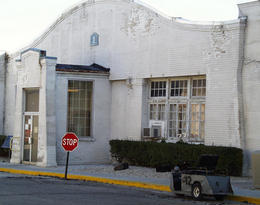
The window with the air conditioner was once the window of
Orville's office. It's not known when the entranceway was
built, but it was not part of the original building.
|
|
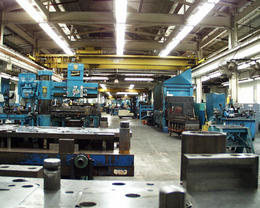
Looking down the length of Building No. 2 in 2002, when it was still
being used by Delphi to manufacture small parts. It's not as
long as it used to be owing to the steam plant.
|
wright laboratory memorial
15 North Broadway, Dayton, OH 45402
After Orville sold the Wright Company and left airplane
manufacturing behind, his built a personal research
laboratory on Broadway Street in West Dayton, less than a
block from his old bicycle shop. Originally, this laboratory
had been the dream of both brothers. When they first tried
to sell their invention to the US Army, they offered all
patent rights in return for enough money to set themselves
up in a professional research facility, much like Thomas
Edison in Menlo Park. It was from here that Orville
consulted for or worked with other research establishments.
Using a state-of-the-art wind tunnel – much more capable
than anything he and Wilbur had dreamed off – he did the
first lift/drag survey of air foils shapes for the US Army.
He helped Charles Kettering design the Liberty Eagle,
the first attempt at a guided missile. He consulted with
Chrysler Motors and helped conduct wind tunnel studies which
resulted in the first aerodynamic automobiles, the DeSoto
and Chrysler Airflow. He was the co-designer of
split-flaps used on dive bombers in World War II, even
helped to build a code machine for the US Navy. Orville
worked almost until the day he died; he suffered a heart
attack in this office in 1948, then succumbed three days
later. The laboratory and the land it rested upon was sold
to Standard Oil of Ohio in 1971 to build a gas station. The
laboratory was razed, but the station was never built. Today
there is a memorial with a statue of Orville
holding a propeller beside a workbench. The tableau is
handsomely sculpted but conveys misleading information.
That particular propeller was designed for the 1903 Flyer I
and was created in the Wright bike
shop long before the lab was built. And it was the doing of
Wilbur, not Orville. What Orville accomplished in later life
at this laboratory had little to do with propellers. The
real story was his growing influence as the grand old man of
aviation and the guidance he offered to an emerging
industry. Tough to show in a statue.
-
CLICK
HERE to visit the Wright Laboratory Memorial in Google Earth.
|
|
|

The entranceway to the Wright Laboratory Memorial echoes the
front of the razed building. The bricks of the laboratory
were saved when the building was torn down but disappeared
before the memorial was built.
|
|
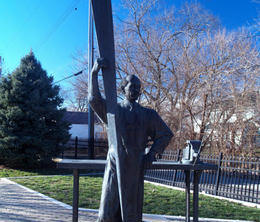
Orville, holding a propeller that was made by Wilbur in a
location about a half block away.
|
|
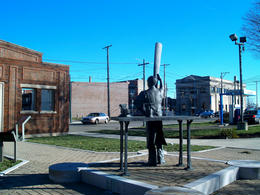
The intersection of Third and Broadway, just beyond the
statue, is where Orville and Wilbur had their first joint
business, a print shop.
|
|
|
|
|

